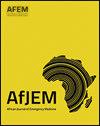急性儿科疼痛管理:对南非夸祖鲁-纳塔尔省区域医院医生的知识、态度和报告做法的调查
IF 1.2
4区 医学
Q3 EMERGENCY MEDICINE
引用次数: 0
摘要
尽管在药物和非药物疼痛管理方面都取得了进展,但儿童仍然容易受到少效镇痛的影响。了解临床实践和治疗临床医生遇到的障碍对于告知有针对性的干预措施至关重要。本研究旨在检查知识,态度和报告的医生在夸祖鲁-纳塔尔省农村地区医院管理急性儿科疼痛的做法,南非。方法于2024年1 - 2月对3家地区医院急诊科、儿科、外科和骨科的医生进行电子调查。该调查包括封闭和开放式问题,涉及止痛药的选择,临床协议的认识,以及有效疼痛管理的感知障碍。描述性统计用于总结总体趋势。事后亚组分析采用卡方检验和Fisher精确检验。计算比值比来描述显著相关性。结果165名临床医生中,131名有反应(有效率:80%)。超过一半(55.7%)的人报告儿科疼痛管理培训不足,只有42%的人知道部门协议。对乙酰氨基酚是最常用的镇痛药。主要障碍包括时间限制、药物获取受限和部门文化。儿科对科室儿科疼痛方案的知晓率最高(82.9%)(χ²,p<0.001)。儿科医生报告说,在多种情况和程序中,非药物方法的使用明显增加。急诊医学受访者更频繁地报告阿片类药物治疗严重腹痛(OR=4.24, p<0.001, 95% CI 1.96-9.14)。障碍因学科而异。儿科提到疼痛评估的困难,而骨科主要报告时间和人员限制。结论:在南部非洲,儿童疼痛仍然很常见,但尚未得到充分解决。本研究确定培训不足、难以获得镇痛药和部门实践是主要障碍。需要针对具体情况、具有成本效益的多模式战略和量身定制的教育来改善护理。可持续发展需要文化变革、更好的培训和跨学科合作,以确保公平的疼痛管理。本文章由计算机程序翻译,如有差异,请以英文原文为准。
Acute paediatric pain management: A survey of doctors’ knowledge, attitudes and reported practices at regional hospitals in KwaZulu-Natal, South Africa
Background
Despite advances in both pharmacological and non-pharmacological pain management, children remain vulnerable to oligoanalgesia. Understanding clinical practices and barriers encountered by treating clinicians is essential to inform targeted interventions. This study aimed to examine knowledge, attitudes and reported practices of doctors managing acute paediatric pain in rural regional hospitals in KwaZulu-Natal, South Africa.
Methods
An electronic survey was distributed between January and February 2024 to doctors working in the departments of Emergency Medicine, Paediatrics, Surgery, and Orthopaedics at three regional hospitals. The survey included both closed- and open-ended questions addressing analgesic choices, awareness of clinical protocols, and perceived barriers to effective pain management. Descriptive statistics were used to summarise overall trends. Post hoc subgroup analyses were conducted using Chi-square and Fisher’s exact tests. Odds ratios were calculated to describe significant associations.
Results
Of 165 clinicians approached, 131 responded (response rate: 80%). Over half (55.7%) reported inadequate training for paediatric pain management, and only 42% were aware of departmental protocols. Paracetamol was the most commonly used analgesic agent. Key barriers included time constraints, limited drug access, and departmental culture. Awareness of departmental paediatric pain protocols was highest (82,9%) in Paediatrics (χ², p<0.001). Paediatric doctors reported significantly greater use of non-pharmacological methods across multiple conditions and procedures. Emergency Medicine respondents more frequently reported opioids for severe abdominal pain (OR=4.24, p<0.001, 95% CI 1.96-9.14). Barriers varied by discipline. Paediatrics cited difficulties with pain assessment, while Orthopaedics primarily reported time and staffing constraints.
Conclusion
Paediatric pain remains common yet inadequately addressed in Southern Africa. This study identifies insufficient training, poor access to analgesia, and departmental practices as key barriers. Context-specific, cost-effective, multimodal strategies and tailored education are needed to improve care. Sustainable progress requires cultural change, better training, and interdisciplinary collaboration to ensure equitable pain management.
求助全文
通过发布文献求助,成功后即可免费获取论文全文。
去求助
来源期刊

African Journal of Emergency Medicine
EMERGENCY MEDICINE-
CiteScore
2.40
自引率
7.70%
发文量
78
审稿时长
85 days
 求助内容:
求助内容: 应助结果提醒方式:
应助结果提醒方式:


